Te Araroa Trail Information and Hints
After talking to other people doing the trail who come from overseas I realised there are many things that New Zealanders take for granted when doing the trail. I have compiled some notes that may be useful for overseas people planning on doing the trail.
Key Sources of Information
The main Te Araroa webpage (www.teararoa.org.nz) has maps and trail notes.
TA Wiki http://tawiki.org/wiki/Main_Page .This is an excellent site with a number of useful documents and information for planning your Te Araroa walk.
Blogs – Trail Stories Page on Te Araroa webpage (http://www.teararoa.org.nz/trailstories/ )
Blogs page on TA Wiki
Permits and Costs
There is no permit needed to do the Te Araroa Trail or to be on public land. The only exception is for section, Queen Charlotte Track, which has a permit and fee ($18).
It is recommended that those walking the trail make a donation to the Te Araroa Trust through their website to help them maintain/build the tracks and signs.
The only other track cost is the Department of Conservation 6 Month Hut Pass.
The Tracks
The key thing to be aware of is what New Zealand calls tracks many of you will think are just animal trails or jungle paths. New Zealand tracks are what a Real Estate Agent would call “natural”. There are some (very few) sections which are lovely graded paths which you do not require to avoid any obstacles but most of what Te Araroa walks over is a lot rougher than this. At the least there will be roots on the tracks but also rocks, blown over trees, mud, tussock and sometimes the track is walking in a river or on sand.

Track on beaches, mud and bush

Track on thick bush, rivers, overgrown grass tracks and roots
In addition New Zealanders don’t really like switchbacks. We are a direct people and this applies to our tracks. Straight up and straight down is the way most of our tracks go. As New Zealand is a hilly country this means you will be doing a lot of climbing and descending, often on very steep, and often slippery, slopes.

Straight-up and straight through
The key reason I mention these things is so those of you more familiar with the tracks of Europe and North America do not think you can average 40 km (25 mile) days unless you are a freak of nature or running. There will be days when you can do this sort of mileage but it will seldom be when you are in the Native Bush or High Country (mountains and tussock dominated terrain). The rough tracks and frequent ups and downs mean you cannot get into a rhythm when walking and are frequently stepping/climbing over things which will tire you out more quickly than you expect and slow you down.
If you are scared of heights you will be challenged in several places. Due to our love of taking direct routes there will be times where you are climbing or descending steep rock with large drops below or beside you. When the tracks have to go along the side of a hill (in Kiwi this is called to “Sidle”) there is often only a very narrow shelf to place your feet and there will be times where you are on these narrow tracks looking down a near cliff to a river several meters below. Now hundreds of people walk these tracks with no issues but it is something to be aware of if heights are a major issue with you.
When planning use the timings in the Te Araroa Trail Notes or on the Department of Conservation (DOC) signs. You will note that most trail signs give time and not distance (though new DOC signs are now giving both). This is because the condition of the track and the trail can really affect how fast you can go. Once you become a super fit Te Araroa Tramper (hiker) you will most likely be much faster than the given timings but take note if the timings change from a 3 km/h to 2 km/h recommended time as this is the difference between a good condition track and an average condition track. There are some tracks where you will be going slower than 2 km/h. To make it even more difficult the recommended track times are not consistent. Some seem to have used a 80 year old grandmother with a zimmer frame to get the track time and some seem to have used a professional trail runner on energy drinks. However on the whole the track times are what an average person is expected to do. Learn how you compare to this average person and then use that as your gauge. For example if I see a track is saying 3 hours I would expect to do it in 2 hours 30 on average.
 Lots of climbing
Lots of climbing
There are three main types of track markers on the trail; Department of Conservation (DOC) markers, Te Araroa signs and other markers.
Track Markers
The DOC signs are either orange triangles or metal poles with orange cylinders attached to the top. The key thing to remember is these markers are the same for all the DOC tracks in New Zealand and are not just for Te Araroa. This means when you see these markers do not follow unless you are sure it is the right track. The standard of track marking varies widely and you just need to take it as it comes. Where the track is not well marked it is important to navigate using Map, compass or GPS to stay on the trail and take special care at intersections. Generally the direction of the point on the orange triangle is the direction you should be going. Where the trail is not well marked follow the direction of the arrow until you see the next marker. Another technique is to look at the back of the marker and see what direction the arrow is meant to be seen from and walk in that direction.
Be aware you will see triangle markers of different colours like blue, yellow and pink. Do not follow these ever. These markers are for trapping or bait lines to control pests.
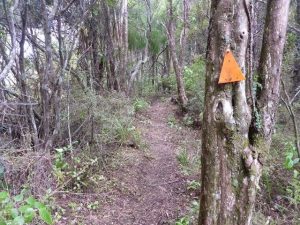
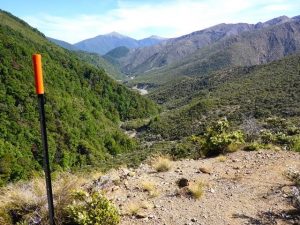
Orange Triangle Steel Post and Orange cylinder Marker

Standard DOC signpost. This is a more modern one as it has distance as well as time
Other Markers. Sometimes the Te Araroa trail follows tracks built by City Councils or volunteer groups. The standard of these markers ranges from fantastic to barely visible. At all times make sure you know where you are on the map.The Te Araroa trail markers are used on the tracks where the track is not on DOC land and the trail has been established by the Te Araroa trust. These range from ‘fingers’ on street signs to Te Araroa Labels with arrows to just the Te Araroa style arrow.
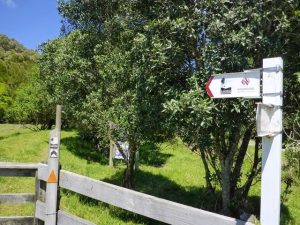
Both Finger Sign on white signpost on right and the smaller Te Araroa Sign and arrow on left
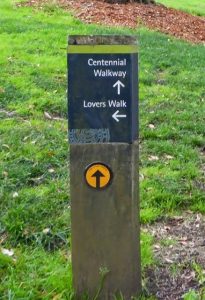
Example of a regional marker, the black arrow in yellow circle
River crossings
(Information and comments from NZ Mountain Safety Council. I recommend reading the brochures Going Outdoors?, Hypothermia, Plan to Survive, River Safety which can be downloaded from this link http://www.mountainsafety.org.nz/Safety-Tips/Free-Downloads.asp)
Rivers are one of the greatest hazards in the New Zealand Outdoors. Errors of judgement often have serious consequences. There is an average of about three river-crossing deaths each year. Eighty per cent of these accidents are in flooded rivers or side-streams.
It’s not only the untrained who die. Experienced and skilled people have drowned after being tempted to give it a go against their better judgement.
You should not take any river crossing lightly: the risks are too great. You must take particular care with children playing in or near moving water.
Whenever possible, plan to use bridges or cableways to cross rivers.
The problems of cold water. New Zealand rivers are often only just above freezing point, especially when they drain a glacier. Even a short time in the water causes rapid cooling of your legs and feet, resulting in poor co-ordination and cramping. With deep crossings, the shock of cold water may cause a rapid and involuntary intake of breath. There is a risk of drowning from gulping water. It may help to splash your face before crossing to condition yourself. Prolonged crossings, or long gorge trips with many crossings, may lead to hypothermia. You can reduce this danger by choosing a route and a method which minimise your time in the water. After deep crossings, it may be best to stop and make a hot drink, change into dry clothes, and rest.
Before you or your party attempt to cross a river, there are questions you need to ask
- Should we cross? If in doubt, stay out.
- Where do we cross? The choice of the safest place to cross is vital. Try to view the river from a high bank. You may be able to see gravel spits or sandbanks just below the surface and get some idea of the depth and position of channels.
3. How do we cross? Use mutual support methods. The more people in the party, the more strength there is for crossing and for supporting anyone who slips or falls. All river-crossing methods have their advantages and disadvantages and, in difficult conditions, no method is absolutely safe. (my comment – If you are by yourself place your walking pole upstream and brace off that. Even better if you have two poles always have one firmly planted before moving the next)
Knowing when to cross a river is not a black and white decision, it’s about good judgement. We advise that you attend a Mountain Safety River Safety Course to learn how to anticipate what might go wrong and therefore recognise and avoid potential problems.
Tides
Download one of the many applications for NZ Tides (I used NZ Tide Times which works without needing reception). Knowledge of high and low tides is needed to negotiate the many beaches in Northland and Auckland as well as Wanganui, wellington and near the end between Riverton and Invercargill.
Day 1 as soon as you have descended down to the beach there are some rocks that cannot be negotiated in high tide. IF you reach it at high tide you will need to scramble through the thick scrub above the rocks. I got lucky and found the blue tape marked track but I know many people struggled for a long time to get through the difficult vegetation.
On 90 Mile Beach most of it is negotiable regardless of tide but some of the bigger rivers will be very difficult at high tide and some of the bays fill with water.
Northland. Many of the beaches are walkable at high tide but you will be in soft sand which will make walking difficult. There are some rivers and mud flats which are only crossable at low tide.
Auckland. In the northern part there are some beaches that cannot be walked at high tide and road alternates are available but not as much fun. There is one major crossing of a mud flat and river after Stillwater which must be done at low tide. I did it right on low tide and it was still chest deep due to the moon state meaning higher tides.
Wanganui. At high tide the walk will be in soft sand and tiring.
Wellington. Beaches still walkable in high tide
Southland. After Colic Bay the beach will be very difficult to walk on as it is loose stones only at high tide. Low tide there is smooth sand to walk on. There is one river crossing which needs to be done at low to mid tide between Riverton and Southland. Some small stretches of this beach will be reduced to soft sand.
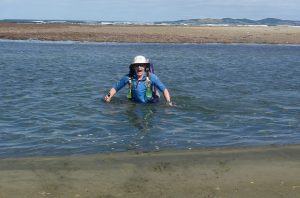
Oops! I forgot to check the tide time for the last river.
Roads
Be aware there are long sections of road walking. The Te Araroa Trust have done an amazing job of getting most of the trail off road but there are still many sections where it is not possible to walk off trail (normally due to landowner’s not giving permission as is their right in New Zealand). 95% of these roads are quiet roads where there is very little traffic. There are a couple of stretches where you will be walking on busy roads but most of the time there is a small shoulder to walk on.
You will be walking on metal (gravel) roads and tarseal roads. New Zealanders drive on the left side of the road.
On the bigger roads, i.e. those with two lanes I recommend walking on the right hand side of the road so you can see the oncoming traffic. On smaller roads I recommend you walk on the outside corner so oncoming vehicles in either direction have more chance of seeing you.
If you are walking at night or in rain make sure you have your torch on, and flashing if you have that option, so vehicles can see you. Walking is not common on NZ roads so most drivers will not be expecting to see a person walking on or beside the road.
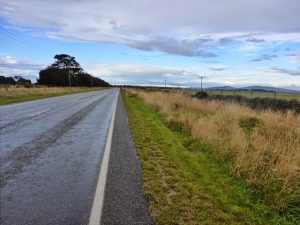
Sealed Road with nice shoulder (side of road) to walk on
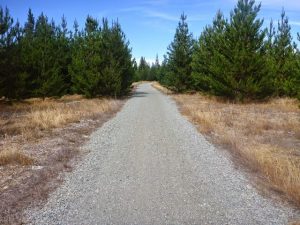
Metal (Gravel) Road
You will experience varied levels of courtesy from vehicles crossing to the other lane to give you room to vehicles veering towards you (in my experience old ladies tended to steer towards me as they were looking at me which is very unsettling). Be defensive and while music is a common technique for the boredom some people experience I recommend make sure you can still hear the cars.
Hitchhiking
Many Te Araroa Trampers end up hitchhiking at some stage of their journey. Non Purists hitchhike most of the roads. Purists will sometimes hitchhike to resupply locations.
New Zealand is a safer country than many to hitchhike but there are still risks and normal precautions should be taken, especially by single females. That said single females have a big advantage when hitchhiking and will generally not have to wait long for a ride. But even groups of 2-4 men managed to get rides fairly easily most of the time. Many NZers appreciate trampers (hikers) so distinguishing yourself as a tramper and not normal backpacker will also increase your chances.
The standard international ‘thumbs up’ works in NZ.
The Weather
New Zealand is an island and as such has changeable weather. On the whole New Zealand is a temperate climate with no major extremes between summer and winter but you can get a wide range of weather in a very close timeframe. Many times I was walking in heavy rain with hands numb from the cold with no sign of it clearing and then 2 hours later it was blue sky and I was too hot.
The key point is you need to bring clothing suitable for hot summer with temperatures averaging mid 20’s (celcius) but sometimes up to mid 30’s, as well as winter conditions around freezing level. In the mountains you can get snow all year around. There were a few times during my walk when the snow came down to 900 meters above sea level and once down to 700 meters all in the month of February. The track goes above these heights regularly in the South Island. I remember meeting some people less than 2 weeks in who had sent their thermals down to Auckland (or it may have been Wellington) in an effort to lighten their load at the end of 90 mile beach. A cold snap then came through and they were freezing. One thing to remember is that the only thing south of NZ is a rather large ice block in the form of Antarctica so when we get a Southerly wind it is cold.
Rain is common at all times of the year so good waterproof jackets are essential. I was fairly lucky with the weather in only having 2 full days of rain, though several more with part days rain, but those that started in Mid October had rain most of the way down the North Island. There were several who pulled out, or nearly pulled out, because they had rain for ¾ of their time.
The New Zealand Sun is very strong. The hole in the Ozone layer is above New Zealand and Australia so we do not have the natural filter that the rest of the world has. As a result you will get burnt a lot quicker than you expect to, even on a cloudy day.
Resupply
Go to the TA Wiki site for more detail on resupply options.
In the North Island you can resupply as you go when passing through the bigger towns. In the South Island this is not possible without some long hitchhikes and it is recommended to mail parcels ahead. You can either mail them to places you will be staying or use the NZ Post Poste Restrante system, though the south island is sparce in Post Offices on the trail.
My method as I had the luxury of my parents to help with mailing resupply parcels was to buy in bulk at the start of the trail for dinners, breakfasts and some snacks and have them mailed to my rest day accommodation. I would then buy lunches and the rest of the snacks as I went. In the South Island I mailed full resupply to; Pelorus Bridge Campground to cover the Richmond Ranges, St Arnaud Alpine Lodge to cover Nelson Lakes, Boyle Outdoor Centre to cover Lake Sumner, Harpers Pass and Minga/Deception and finally to Arthurs Pass YHA to cover to Rakia River. All of these places had no, or very limited, resupply shops. From then I went back to the North Island technique as Lake Tekapo, Wanaka, Queenstown and Te Anau (23km hitchhike off the trail) had good supermarkets.
Accomodation
Huts.
New Zealand has a fantastic network of over 900 huts managed by the Department of Conservation. These huts range from a basic bunk, mattress and bench with long-drop toilets to fancy huts with running water inside. I met a few people who said they would not be using the huts but they very quickly changed their minds – usually when it was raining.
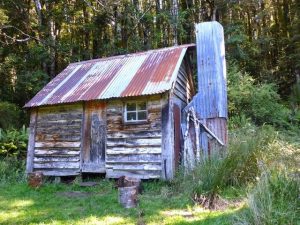
One of the older Huts but still has mattresses

A more modern Hut
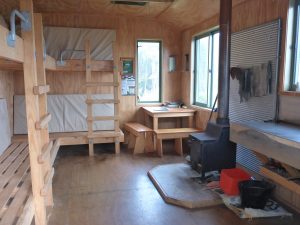
Standard layout of bunks with mattresses, bench, table and a fire
There is a fee for using these huts which goes to the maintenance of the huts. You either need to pre purchase hut tickets which range from $5-$15 depending on the type of hut or you can buy a 6 month ($92) or 12 month ($122) Hut pass which means you can use any hut anywhere in the country for an unlimited amount of time (within the time of your pass) except for the Great Walk huts of which for Te Araroa are on the Tongariro Crossing and Wanganui River. These are fantastic value for money and I strongly recommend you buy a pass. You need to visit a DOC office which can be done in Auckland, Hamilton or Te Kuiti. There are no huts north of Hamilton which is why you can wait before buying one. Just be aware that DOC offices are closed on weekends. The first hut is on Mt Pirongia but this has just been replaced with a new hut which will be going on the Online Booking System and it is still being discussed if your hut pass will cover this or not.
Hut Etiquette.
– Huts are first come first serve basis. You cannot reserve a bunk and you cannot send a friend ahead to reserve a bunk for you.
– Be considerate of other people in huts. Keep your gear on your own bunk and when you have finished cooking clean your space and clear it so others can use it.
– Before you leave lean your mattress against the wall. This is to stop the mice going to the toilet all over it and to air it out.
– Carry all of your rubbish out with you. Leaving it in the fire is not a valid option and burying it is also not acceptable.
– The last one out of the hut is to check that it is clean; wipe down benches and table, ensure the fire is out and ashes removed, all mattresses leaning against walls and floor swept.
– If you use firewood then you need to replace it.
– Make sure you have purchased a Hut Pass (get the 6 month pass as it works out cheaper than buying per hut for most people)
Hut Books
In every hut there is a book either called Visitor Book or Guest Book. This book serves three purposes; search and rescue tool, DOC statistics and entertainment.
In the event of a search and rescue operation a key tool is using hut books to narrow down the search area. This is why even when you are not staying in the hut you should fill in your details. As a solo tramper I am vigilant at putting my details in every hut I come near.
DOC uses the Hut Books to determine how many people are using the huts. This information is then used to determine the priorities for the small maintenance budget they have. The more people who use a hut the more likely that hut will be maintained. Huts that are not visited will be decommissioned. Therefore I encourage all Te Araroa walkers to fill in hut books to ensure the huts on the trail are maintained for our use in the future.
The entertainment is in seeing who is in front of you and how far in front and to read what comments some people make. I love the routine of arriving at a hut and reading the book while having a cup of tea.

Inside of the Hut Book (note entry for Clarke party – she was Prime Minister at the time)
Most of the accommodation in the north island will be your tent. It is free to camp on DOC land except when camping at a serviced hut which is $5 with a pre purchased ticket (or Hut Pass) or a Great Walk Hut which is $6-18 depending on peak season or not (Hut Pass not sufficient). Note when on a Great Walk (such as Tongariro Crossing and Wanganui River) you are not allowed to camp within 500 meters of the track. Given the rough terrain and vegetation this effectively means only camping by huts.
Tents.
You must get permission before camping on private land. Usually landowners are more than happy to let you camp and often people who asked to camp on peoples’ land ended up being invited into their homes. If you do not ask permission and get caught worst case you may find a grumpy farmer who will call the police for trespassing though this would be unusual. However they may refuse access for all future Te Araroa people on their land.
Non DOC public land varies on whether you can camp or not so go by the rule if there is no sign forbidding camping then you can. I spent a few nights under trees on the side of the road which is public land.
Backpackers
Backpackers are a good option for rest days. They range from $22-35 for a dorm room and $40-80 for a double room. I recommend joining YHA ($24) and applying for their Low Carbon Discount letter which gives a good discount. You need to send an email to their headquarters (see their website for contact details) giving them the dates of your TA walk and requesting Low Carbon Letter. Then when you book tell them you are Low Carbon traveller. This reduced the price of dorm to $19 in most places. All backpackers have kitchen, lounge and laundry facilities and WiFi though some will make you pay for this. YHA members have free WiFi. Laundry will cost $2-4 and dryers $4 but washing lines will be available in most places. Some places will hire you a towel so you don’t have to use your tiny lightweight camp cloth.
Holiday Parks/Campgrounds
There are holiday parks in nearly every small town. Be aware that if you are travelling in peak season they will be charging a lot just for a tent. Prices range from $8-$35. Most of these places will also have Cabins available which protects you from the rain and gives room to sort your gear. These will be from $40-$80. Holiday Parks will have a kitchen, toilets, showers and most times a laundry. Some places will use coin operated showers so you have to pay more money over your campsite fees. Laundry will cost similar to backpackers.
Dangers
New Zealand has very few things that can hurt you. Most of the time it is your actions that will determine the danger and this particularly applies to river crossings, weather and terrain. Be conservative and think carefully before heading into the mountains or crossing a river.
Animals, Birds and Insects
One of the best things about New Zealand is there is nothing dangerous that will hurt you. There are no predators capable of causing harm to you. There are no snakes at all. There are no deadly spiders. NZ has one native poisonous spider that lives on a narrow band on a few beaches. There are some imports from Australia like the White Tail spider that causes a reaction in some people but to most is like a wasp sting. There are tiny populations of Red Back Spider but not near the trail. This leaves you free to concentrate on the trail and not what is living on the trail.
Mice/Rats. You will come across these in the Huts. The hut books will generally mention if there is a worse than normal amount of mice in a hut. Ensure you package your food up and hang it out of mouse reach. For particularly bad huts you need to hang your pack out of reach as well. It is not a bad idea to buy a light plastic mouse trap and set it each night using peanut butter as bait. The Mice will eat through plastic and packs to get at food.
Possums. These make very strange noises at night and scare the crap out of people until they learn it is just possums. They can be an issue around huts as well but most huts are robust enough to keep them out. They do take delight in dancing around on the tin roofs to make as much noise as possible. Generally they will not bother you in a tent but in a particularly bad area keep your food inside the tent and be prepared to make loud noises if they come sniffing around. Possums are a significant enemy of New Zealand nature due to their lack of predators (they come from Australia where they have predators), damage to trees, eating native bird eggs and they are Tuburculosis Carriers which could be devastating to our cattle and deer industries if they spread it. If you manage to kill a possum you will be congratulated and thanked by most New Zealanders.

Possum
Weka. These are found in the South Island and many people mistake them for Kiwis. They will appear around picnic tables and campsites. They are thieves and will take anything they can. If you see a Weka around keep everything in your tent and keep your tent zipped up. They are not afraid to nose into an open tent and help themselves. Wild Pigs. Generally pigs will avoid you but if confronted by one give way!

Weka
Kea. Kea are Mountain Parrots and are very intelligent. They are also thieves and can be destructive to your gear if it is left unattended and they are in a mood. If you see them same rules as for Wekas but if they are around and you are in a tent have someone keep an eye on the tents so they do not decide to destroy them. They are sometimes inquisitive and will approach you but do not feed them no matter how cute they look. They are mountain parrots and as such have a very specific diet and our food is usually harmful to them. If you really want to see them up close then stop in Arthurs Pass as they hang out there stealing food off tourists at the café.
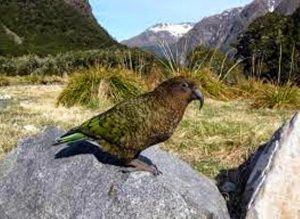
Kea
Other Native Birds. This will be the highlight of your journey. You will be amazed at the amount of birds everywhere and the noises they make in the day and at night. None of them will hurt you.
Sandfly. This will be your number one enemy during your walk. These are small biting insects that live near flowing water (still water is covered by mosquitos). They reduce tough men to tears and it is hilarious watching people do the sandfly dance – from the comfort of your sealed tent. Thankfully they don’t tend to bite through clothing and strong insect repellent will keep them away. It is because of sandflies that tarps are not popular on Te Araroa Trail unless they have an insect net with them.


Sandfly
Wasp. This is the second most common insect people have issues with. It is common to be stung, especially in the upper to central south island. There are several different types with the most likely to be encountered being the Common Wasp and the German Wasp, which look similar as below.

Wasp
White Tail Spider. These are around on the trails but will only bite if threatened. Generally the bite is like a wasp sting but some people do react. In over 20 years of hiking in New Zealand and crawling around on the ground with the Army, I have never been bitten or met anyone who has. On TA I didn’t see any of these.

Whitetail Spider
Mosquitos. There are Mosquitos in New Zealand but they do not carry any diseases. They are not common except in the north of the country where it is warmer. I did not get any Mosquito bites during the whole walk.
Other Mammals. You will walk through farm animals several times on the walk, usually sheep and cows. Sheep will get out of your way. Cows can be curious and sometimes will crowd around you. Just be firm with them to shoo them away gently if they get too close for comfort or push them out of the way. Be aware of bulls in a paddock and keep your eye on them when walking through their paddock. As a general rule bulls on their own need more caution. Other animals you will see a lot of Wasp. These are common in the South Island in the Beech Forests as the wasps are attracted to the Honey Dew Insect that lives in the bark of the trees. In some places there are very high concentrations of wasps. If you are allergic ensure you have your medication handy. I was stung once and I am aware of several other people getting stung.
are goats and deer but they will avoid you. On beaches you may see Seals – give them space!
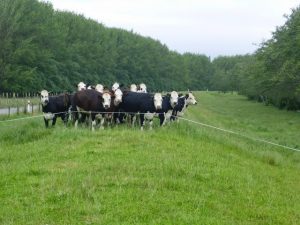

Cows on the track Curious cows to walk through
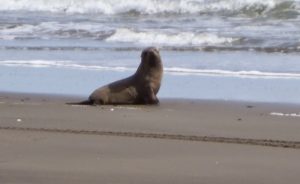
Seal on trail on the beach south of Wanganui
Plants
Supple Jack. This is a vine found in thicker jungle like bush. Be aware of the magical properties of this vine to wrap itself around you, your pack or your poles even when you thought you were well clear of it. If you feel resistance stop immediately and release the vine otherwise you may find yourself on the ground suddenly.

Supple Jack (kareao,pirita)
Bush Lawyer (Tātaramoa). This is a thorny vine that hangs down from trees and bushes. It has thorns and will attach itself to clothes, pack or your skin. If you feel resistance stop immediately and carefully detach it. If you don’t you will end up with rips in your clothes and skin.
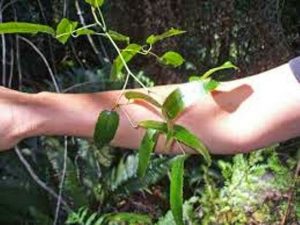
Bush Lawyer
Gorse. This is a thorny plant that you will occasionally have to walk through following an overgrown track. It is prickly and sometimes leaves itchy scratches. This plant has a lovely yellow flower and in hot weather you will hear the seed pods popping.
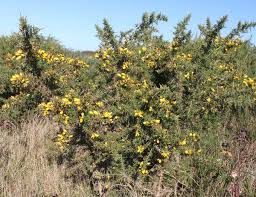

Gorse Bush Close up of Gorse
Matagouri. This is a thorny plant that is common in the south island. You will pass many of these.
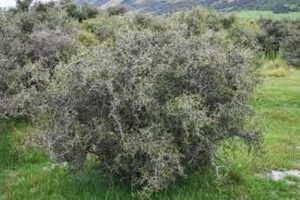
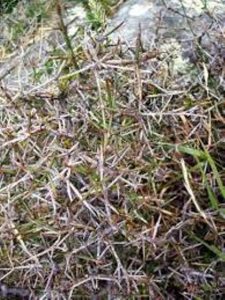
Matagouri Bush Close up of Matagouri
Dog Rose. This is another thorny plant that you will encounter in the south island.

Dog Rose
Speargrass (Spiky Spaniard). These plants look innocent but are vicious. They look like small flax bushes but the leaves are actually solid and tipped with very strong points at ankle and shin level. Often these plants will be hiding under or behind a tussock bush and jump out and ambush unwary trampers. You will find these wherever there is tussock and they start from the Tararuas and continue in the South Island.


Spaniard
Stinging Nettle (Ongaonga). This is a rare plant that lives in wet and sunny areas. It will cause intense pain and in some people swelling. Hint a home remedy to stop the pain is look for a plant living around the same area that the sting nettle do that smell of lemons. Rub these leaves and put over the stinging area. This worked for me as a child.

Stinging Nettle
Tussock. These plants come in a wide variety from delicate ankle height to head height with leaves strong enough to stop forward progress. The key danger is they hide holes which can cause injuries. Whenever you are going through tussock be careful to underneath, or feel underneath with your poles.

Tussock
Electric Fences
New Zealand Farmers commonly use Electric Fences to control their stock. As we are crossing fences often you need to look for the signs which tell you if it is electric or not. The easiest ones are the coloured tapes. The other sign to look for are the insulators on the fence posts. While the shock will not kill you (unless you have a heart condition) they do hurt – a lot, especially the steel wire ones.
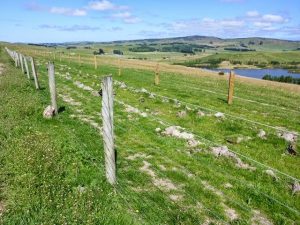
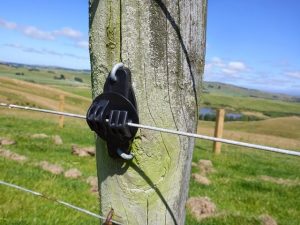
Electric Fence – look for the black insulators Electric Fence Insulator
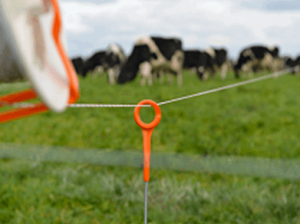
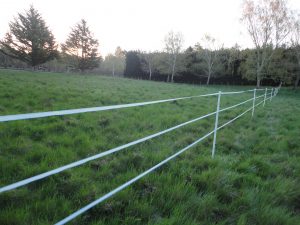
String Version and Tape version of electric fence
Views: 10528

It’s a shame yoou don’t havfe a donate button! I’d most
certainly doonate too this brilliznt blog! I supppse ffor nnow i’ll settrle
foor book-marking aand addiung yoir RSS feed tto myy Gogle account.
I lolk forward to brabd neww updates and will sare this blog
with myy Facwbook group. Chatt soon!
Hello
Congratulation with the PCT, very impressive.
I will start hiking the TA in the beginning of Oct and have a couple of questions. Can u recommend a mobile operator that has good net connection on NZ. What about water cleaning? Is it necessary to filter it all over NZ? I see in ur gear list that u mention water purifier. Have u practiced rowing lately😊 Read ur blog from NPL, the lake Pauro crossing. Walked there ln July and I could not see any angry people just after u passed😊 Very few people walk here so think the one u met was the next to cross.
Best regards
Eirik Sorensen.
easor@online.no
@eirikarnes_adventure
Thanks Eirik. Well done on the decision to do TA. I hope you enjoy it as much as I did. There is not a lot of difference with the phone companies, some are good one one area but not others. Spark used to have the best coverage but not anymore. I use 2 Degrees as it is the best value and great customer service. They tap into Vodacom towers. Purifying water is needed anywhere there are farm animals or humans. I filtered unless I was sure the water source was coming from native forest/mountains. Ha ha, that was one stressful crossing.